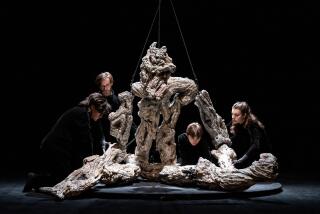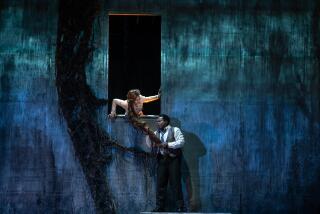Obstructed-View Seating
As season subscribers, my wife and I were anticipating “Pelleas et Melisande.” However, we did not realize that we had purchased “obstructed view seats.”
The idea that Peter Sellars (and the Los Angeles Opera) would write off the entire second balcony (and probably the first balcony as well) is particularly distressing. I have spent my life in the theater (including starring roles in “Camelot” and “Lovely Ladies Kind Gentlemen” at the Dorothy Chandler Pavilion), and I don’t recall ever performing on a set that excluded any portion of the audience.
The TV screens were completely unacceptable--too small to discern individuals. Coupled with Sellars’ lighting, which blinded the balcony, viewing much of the opera became impossible. The lighting also wiped out the supertitles.
What made it even more distressing was the splendid cast of singers who could (and did) act! There seemed to be real motivational forces at work, as well as realistic responses between characters. What a pity that the balcony missed it!
What really burns me is that the set could easily have been moved forward, since there were no crowd scenes demanding space in front of it. As brilliant as Sellars is, he needs to be reminded that his artistic expression means nothing if it cannot be seen!
RONALD HUSMANN
Studio City
*
I have been a loyal L.A. Opera season ticket-holder for six years. This means that my spouse and I attend all of the L.A. Opera performances, but being only humble commercial printers and designers, our seats are in the balcony. On Feb. 10, we went to see “Pelleas et Melisande.” We went, but see . . . that we did not.
When I realized that the reason the TV monitors were there was because the L.A. Opera management knew we were going to see nothing but shoes on stage, I became enraged. Why not send out a card saying, “If you hold balcony seats, stay home and rent the video”?
Now there have been a couple of operas in the past years that have had moments when a balcony viewer lost sight because the set was designed for another opera house. But this monstrosity took the cake, particularly because this was paid for by the L.A. Opera in conjunction with De Nederlandse Opera of Amsterdam. So why didn’t it fit our stage view?
CARMA LIPERR
Glendale
More to Read
The biggest entertainment stories
Get our big stories about Hollywood, film, television, music, arts, culture and more right in your inbox as soon as they publish.
You may occasionally receive promotional content from the Los Angeles Times.










